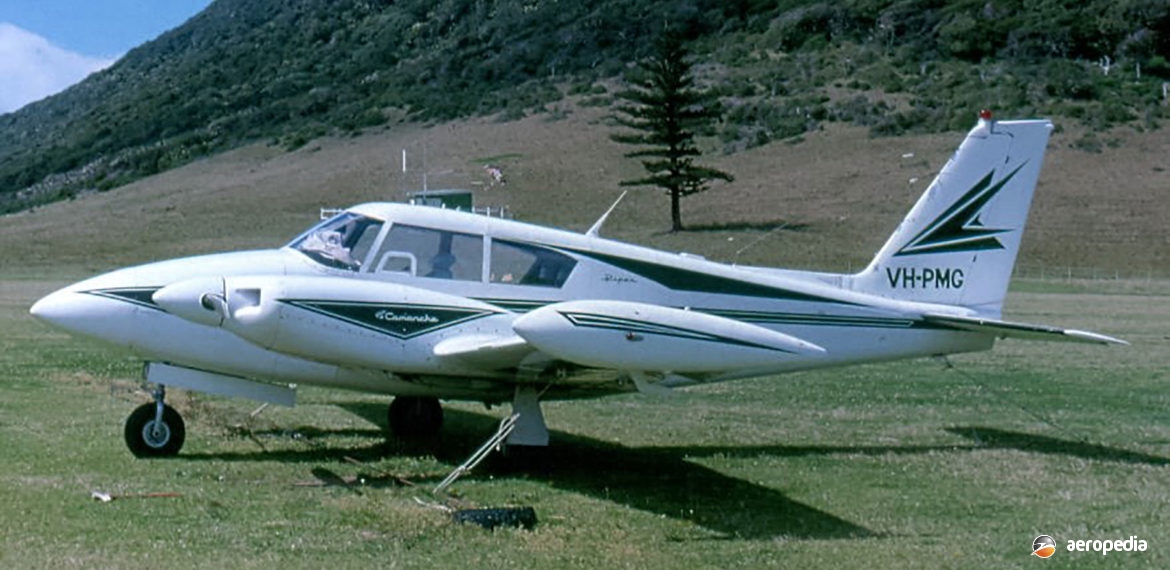Photograph:
Piper PA-30 Twin Comanche 160 VH-PMG (c/n 30-674) at Lord Howe Island in September 1989 (David C Eyre)
Country of origin:
United States of America
Description:
Light twin-engine cabin monoplane
Power Plant:
Two 119 kw (160 hp) Lycoming IO-320-B four-cylinder horizontally-opposed air-cooled engines
Specifications:
- Wingspan: 10.97 m (35 ft 11¾ in)
- Length: 7.67 m (25 ft 2 in)
- Height: 2.51 m (8 ft 2¾ in)
- Wing area: 16.54 m² (178 sq ft)
- Max speed at sea level: 330 km/h (205 mph)
- Max cruising speed at 2,438 m (8,000 ft): 312 km/h (194 mp/h)
- Economical cruising speed at 3,048 m (10,000 ft): 267 km/h (166 mph)
- Initial rate of climb: 445 m/min (1,460 ft/min)
- Service ceiling: 5,669 m (18,600 ft)
- Max fuel range with wingtip tanks fitted: 2,189 km (1,360 miles)
- Empty weight: 1,002 kg (2,210 lb)
- Loaded weight: 1,690 kg (3,725 lb)
History:
The Twin Comanche series was designed to fill a niche in the market for a small economical multi-engined machine which would provide day, night and all-weather utility, geared to small airports and short fields. The prototype was flown for the first time on 7 November 1962, followed by the first production machine on 3 May 1963. Production of this series then commenced at the Company’s facility at Lock Haven in Pennsylvania with deliveries to customers beginning in 1963.
The PA-30 was a development of the single-engine Comanche to a twin. The wing structure remained basically the same but used heavier gauge material in certain areas, and the leading-edge spar was extended outboard of the engine nacelles. The wing area remained the same as the single-engine model. Much of the jigging and tooling of the Comanche was utilised in its production.
In September 1965 the model PA-30B was introduced, with extended cabin windows and an optional cabin arrangement to seat six persons, in lieu of four in the initial production model. Wingtip auxiliary fuel tanks were optional. A further variant of this model, the Twin Comanche C, featured a slightly higher cruising speed and interior improvements. At this stage the series was fitted with 119 kw (160 hp) IO-320-C1A turbo-charged engines, which allowed this model to cruise at 7,315 m (24,000 ft) at 359 km/h (223 mph), and have a maximum speed of 359 km/h (223 mph) at 6,096 m (20,000 ft).
In 1970 the PA-39 series Twin Comanche appeared with minor refinements, using the fuselage, wings and tailplane of the PA-30 but, to improve the aircraft’s stall characteristics, small triangular flow strips were added to the wing leading edges outboard of the engine nacelles. It also had opposite rotating propellers and 119 kw (160 hp) Lycoming engines. Prototype of the PA-39 series was converted from a standard PA-30, the first production PA-39 being completed on 23 December 1969 and deliveries of production aircraft commencing in April of the following year.
Production of the series ceased in June 1972 due to the flooding of the Company’s production facility at Lock Haven, destroying the last 16 aircraft on the production line. At that stage a total of 2,156 aircraft had been completed, comprising 2,001 PA-30s and 155 PA-39s. The last two production PA-39s were delivered to Brazil, the third last being imported to Australia where it has been flown as VH-TDL (c/n 39-152). Examples of each of the PA-30 and PA-39 are registered in New Zealand, and 68 PA-30s and eleven PA-39s are registered in Australia.

